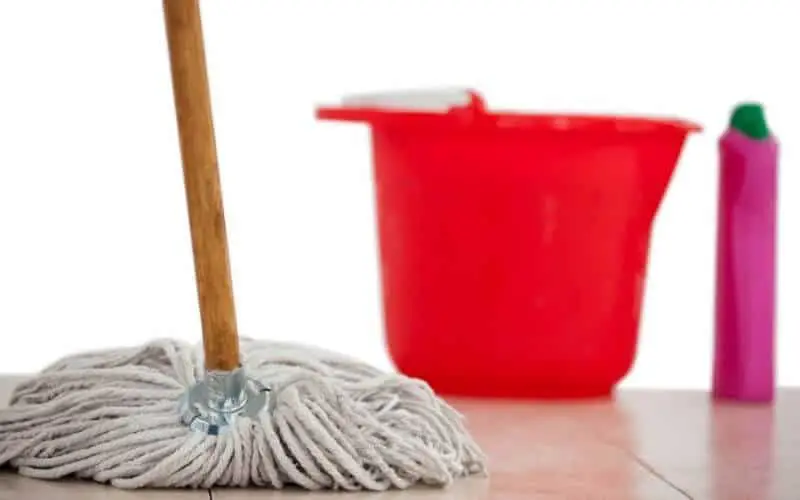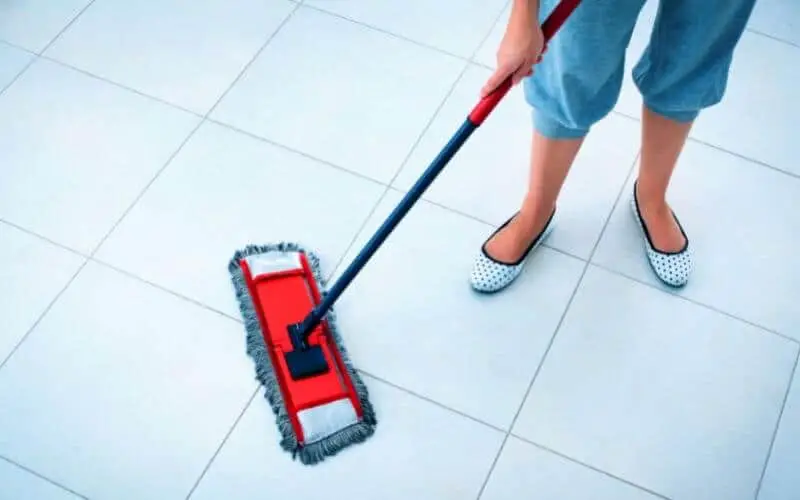The benefits of hydrogen peroxide as a common household staple are quite numerous. This household item serves as both a cleaner and a disinfectant that kills harmful viruses, bacteria, and fungus. Most importantly, hydrogen peroxide is affordable and can be used to clean literally anything that needs to be cleaned.
This post is, however, majorly concerned with cleaning floors with hydrogen peroxide. You will need to make a water and hydrogen peroxide mixture and then mop the floor. Also, hydrogen peroxide and baking soda can be used to clean the Grout Lines on your floors.
Read: 4 DIY cleaners for spray mop
What Is Hydrogen Peroxide, And is it Safe to Use?
Table of Contents
Before we delve into how to clean floors with hydrogen peroxide, we must examine this common household item and how safe it is to use.
Hydrogen peroxide is a combination of water and hydrogen that is clear as water. The substance has antiviral, antibacterial, antimicrobial, and disinfectant properties. This has made it a popular household item over the years.
The versatility of hydrogen peroxide cannot be overstated. The liquid can be used for its disinfectant qualities as a bleaching agent, hair dye, toothpaste, mouthwash, laundry stain remover, and bathroom cleaner.
A follow-up question will be, how safe is this liquid? It is quite obvious that hydrogen peroxide shouldn’t be ingested. Thus, it should be kept away from the reach of children and pets.
Over-the-counter hydrogen peroxide has more water percentage and about 3% of hydrogen peroxide. Most times, when used as a cleaning or bleaching agent, it will need to be diluted.
Hydrogen peroxide shouldn’t be combined with vinegar under any circumstance as it can create an adverse reaction.
Read: How to remove black urine stain from hardwood floor
Cleaning Floors With Hydrogen Peroxide
Cleaning your floor with hydrogen peroxide to give it that shiny look is something you should try out to brighten dull floors. Follow the steps outlined below to clean your floor with hydrogen peroxide:
1. Firstly, you should make the hydrogen peroxide and water mixture. Start by mixing 1 cup of 35 percent peroxide solution with a gallon of water in a bucket or big bowl.
2. A nonabrasive cloth or a microfiber mop should be used in cleaning (natural fiber mops are not recommended because they spread too much water). Start by cleaning from section to section and dry with a separate rag immediately you are done with a section
3. To clean out a particular stain, transfer the water and hydrogen peroxide mixture in a spray can and spray the affected area.
4. For stubborn stains like pet stains, dip paper towels into 3 percent peroxide and spray the towels over the affected area. Leave the towels over the stain for some hours, occasionally spraying with peroxide to keep them wet. When removing the towels, sprinkle baking soda liberally on the stain and leave it there until it dries. Then sweep away the residues.
5. Note that hydrogen peroxide being a bleaching agent, can leave a permanent mark on your floor. Thus, it should be used with care. If you’re faced with such circumstances, your only option is to sand it off the affected area or better still, call a professional to deal with the damage.
Using Hydrogen Peroxide to Clean Grout Line on Floors
Having grout lines on your tiles and floor can be quite disgusting. While Hydrogen Peroxide serves as a cleaning and bleaching agent, it might not be strong enough to get rid of stubborn grout lines. Follow the steps outlined to clear up grout lines from your floors:
1. Make a mixture of one cup of baking soda, half cup of hydrogen peroxide, and two teaspoons of dishwashing soap to that. This mixture is regarded as the magic potion that clears up grout lines
2. Clean and dust the floor thoroughly before applying the mixture. You don’t need debris and specks of dirt interrupting your work. To clean up the loose dirt in the grout lines thoroughly, use a brush to scrub the dirt repeatedly.
3. Apply the mixture over the grout lines once you’re done cleaning and dusting. To get the grout lines specifically, you can use a teaspoon to apply it. If you want to brighten your whole tiles, you need to apply the paste all over, then give it at least ten minutes. Make sure it doesn’t dry down. It must remain wet.
4. Scrub the mixture off the floor using a scrubby pad if you applied the mixture all over the floor. If it’s over the grout lines, use a toothbrush to precisely clean the narrow grout lines.
5. Sweep the floor with a tile floor cleaner machine or wet-dry vacuum the area.
Read: How to change grout color on tile
Other Uses of Hydrogen Peroxide
Apart from being used to clean floors, this versatile liquid has other uses like
1. Refinishing metal objects
2. sanitizing your kitchen utensils such as cutting boards, ceramic-coated cookware, microwave, refrigerator, coffee maker, blender, slow cooker, dishwasher, etc
3. Freshening up your furniture affected by harsh chemicals
4. Cleaning your mirrors
5. Removing stains from your clothes
6. Eliminating bad odors like skunk smells, urine odors, and other offensive odors.
Read: How to clean floor tiles naturally
Conclusion
If you are not exactly a big fan of chemical-filled cleaners, hydrogen peroxide is a good alternative for you. Most importantly, this very versatile liquid can serve as both a cleaner and sanitizer for your home.
Are you thinking of cleaning floors with hydrogen peroxide? This post will prove quite useful. In a bid to get tough stains out of your floors, never attempt to mix hydrogen peroxide with bleach, as this can cause an explosion.

